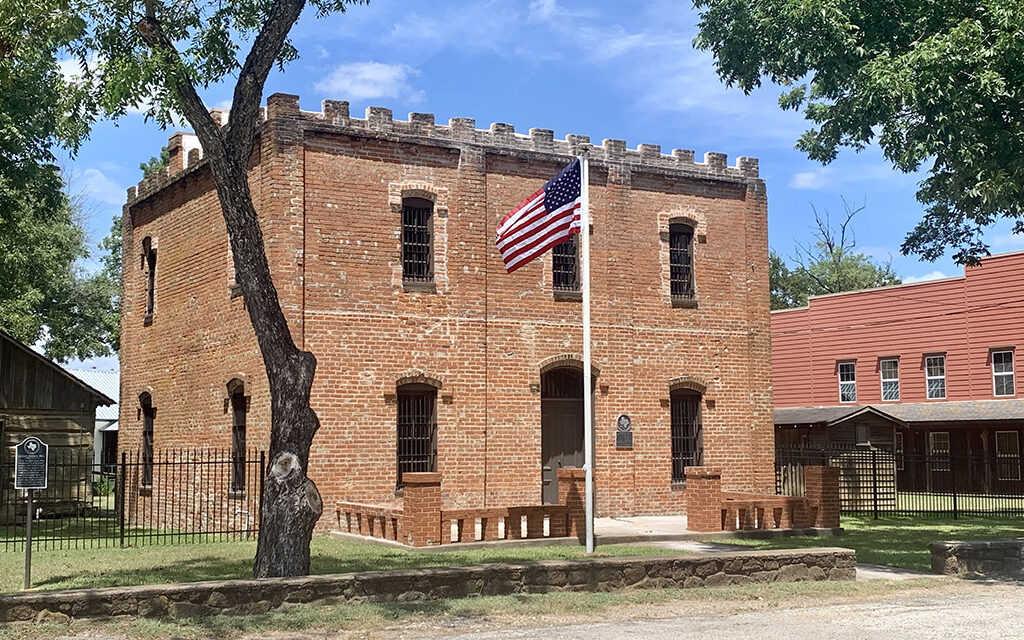for the NEW “1881 Freestone County Jail” MARKER
The Freestone County Historical Museum will hold a dedication ceremony for its newly obtained CORRECTED 1881 Freestone County Jail marker, Saturday, Oct. 5th at 10:00 am.
The original Texas Historical Marker was dedicated on May 7, 1967 with 1,000 people estimated to be in attendance for the opening day of the museum some 57 years ago. However, at this time, the complete history of the old jail was not understood. The jail was thought to be 110 years old at this time. It was later discovered; yes, there was a brick jail building built on this same location in 1857, known as Jail #2. This building was dismantled in 1881 and a new jail was erected on the same location. It is very interesting that several newspapers recorded in July 1977 that the foundations for the 1857 had been found when doing excavation work for the Carter Cabin chimney with a photo of Mrs. Sylvia Childs, who was a long-time museum curator, showing off the bricks.
(NOTE: DAVISS with 2 s is the correct spelling)
Sheriff Horatio Paxton Daviss (who served from 1879-1880) oversaw the 1881 jail project as chairman of the Jail Committee and received two drafts totaling $2039.77, “being the sums advanced by him for constructing jail”. Sheriff H. P. Daviss also received a minimal payment for serving on the committee; as did D. L. Wingfield, Sr. and Sam Nesbitt, who also served on this committee. The contractor was paid $2,621.68, but his name was not listed in the commissioner court minutes. Total expenses were about $5,000. The 1881 jail building that stands today is known as Freestone County Jail #3.
Henry Jay Childs also was paid for work having to do with deconstruction of the old jail and the construction of a well on this site. Henry Jay Childs was the first sheriff to serve in the newly constructed 1881 Jail building. He carved his initials, H. J. C., in the back door jamb. The initials of another later sheriff, James Norelda Haydon, J. N. H., elected in 1892, are found just below those of Sheriff Childs.
The 1881 building has now served Freestone County for 143 years. It functioned as a jail from 1881-1913, until a similar jail was constructed on the courthouse lawn in 1914. From 1914 until 1966 the old jail served as a boarding house complex with four units. The citizens of Freestone County raised funds in 1966 to purchase the jail and use it for the newly founded Freestone County Historical Museum. From 1966 until 2007 the building was the main building for the museum complex. The jail building was closed from 2007 until Oct. 2, 2021 for renovations to restore the jail back to its 1881 glory. It was during this time frame that the museum board became interested in clearing up the historical errors on the 1967 historical marker. Most of the details on the marker were concerning the 1857 jail. An application was filed with the THC in 2022 to have the marker corrected. This was a long process and the new marker was finally delivered to the museum this summer.
Let it be made known very clearly the claim that John Wesley Hardin may have spent the night in the 1881 jail are simply inaccurate. Yes, he did live in Freestone County during his childhood. His uncle, Emanuel Clements (married to his father’s sister) was the very first sheriff of Freestone County when it was still part of Limestone County. Mr. Clements also served as the first clerk of Freestone in 1851. Mr. Clements’ brother, William, also served as sheriff of Freestone County from 1851-1852. These families later moved from this area to Gonzales County. Hardin was not born until 1853, so he would not have been living when his uncle was serving in his official position in Freestone County.
In 1871, Hardin was arrested in East Texas and they passed through Fairfield on the way to Austin, when Hardin shot and killed the Texas State Policeman, Jim Smalley, who was guarding him and Hardin escaped. John Wesley Hardin was, according to historical reports, in prison from 1878-1894 in Huntsville, Texas. If he were imprisoned during this time frame in Huntsville, he certainly would not have spent the night in the 1881 Freestone County Jail. Newspaper articles from 1871 and 1877 concerning the killing of Jim Smalley, in Freestone County indicate that some of the “folklore” mentioned on the marker may have been true; however, 1871 was ten years in advance of the construction of the current building. There was no mention in the Fairfield Recorder Aug. 23, 1895 obituary of J W Hardin of ever having been in jail in Fairfield, only that they passed through. So most likely he never set foot in the 1857 jail either.
Once these facts were brought to light, the old marker simply needed to be corrected. Patricia Pratt, museum curator, has grown very weary of trying to explain this dis-information over and over again to museum visitors. Hopefully the new marker will set history straight on our little corner of Freestone County History and Texas History. Please come help us celebrate. The museum complex will be open free of charge on this day after the ceremony is completed.




